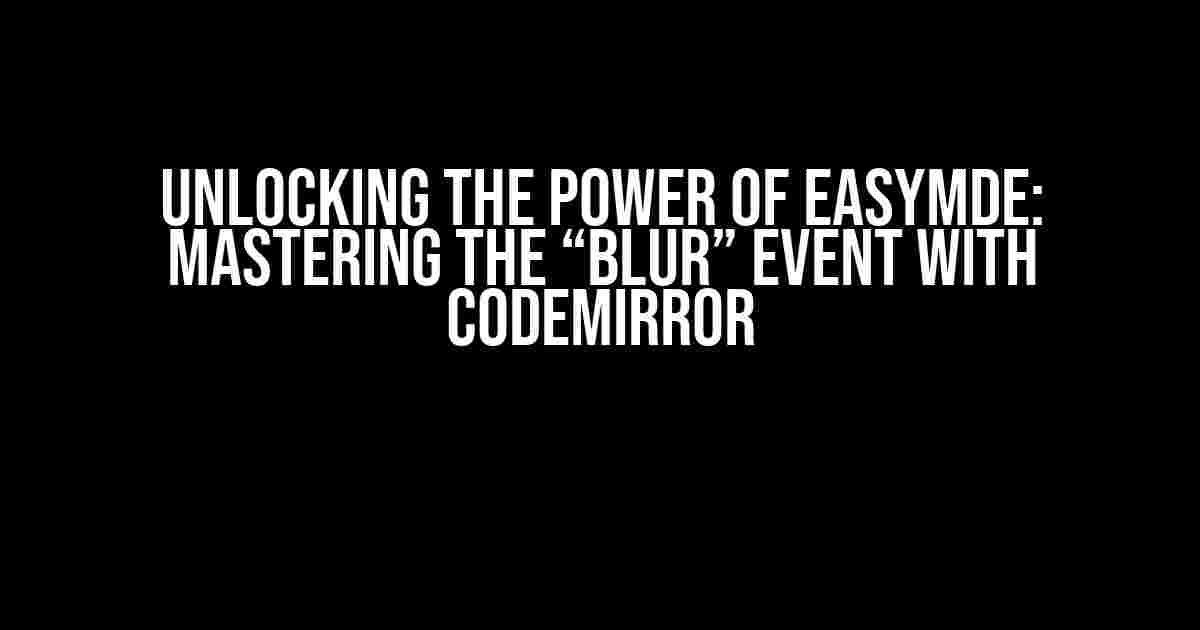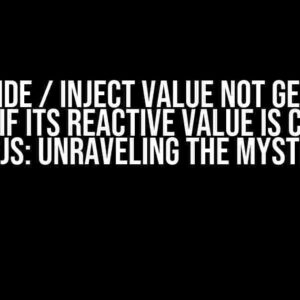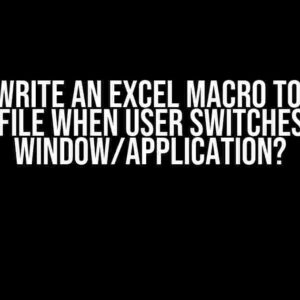Are you tired of struggling with text editors that lack flexibility and customization options? Do you want to take your Markdown editing experience to the next level? Look no further! In this comprehensive guide, we’ll dive into the world of EasyMDE and explore the “blur” event with Codemirror, a powerful combination that will revolutionize the way you edit Markdown texts.
What is EasyMDE?
EasyMDE is a popular, open-source Markdown editor built on top of the Codemirror library. It provides a simple, user-friendly interface for editing Markdown texts, making it an ideal choice for developers, bloggers, and writers. With EasyMDE, you can focus on writing while enjoying features like live preview, auto-save, and syntax highlighting.
What is Codemirror?
Codemirror is a versatile, JavaScript-based text editor that provides a robust foundation for building advanced text editing interfaces. It’s widely used in popular coding platforms like GitHub, Stack Overflow, and Bitbucket. Codemirror’s flexibility and customizability make it an excellent choice for developers seeking to create tailored editing experiences.
The “Blur” Event: Unlocking Hidden Potential
The “blur” event is a powerful feature in Codemirror that allows you to execute custom code when the editor loses focus. In the context of EasyMDE, this event can be leveraged to perform a wide range of tasks, from simple validation checks to complex data processing. In this article, we’ll explore the different ways you can harness the “blur” event to elevate your Markdown editing experience.
Basic “Blur” Event Handling
To get started with the “blur” event, you’ll need to create an instance of the EasyMDE editor and attach an event listener to the `blur` event. Here’s some sample code to get you started:
const easyMDE = new EasyMDE({
selector: "#myTextEditor",
autofocus: true,
maxHeight: "500px",
initialValue: "Hello, World!",
});
easyMDE.codemirror.on("blur", function(cm) {
console.log("Editor lost focus!");
});
In this example, we create an instance of the EasyMDE editor and attach an event listener to the `blur` event using the `on` method. When the editor loses focus, the event listener will log a message to the console.
Validating User Input with the “Blur” Event
One common use case for the “blur” event is to validate user input. For example, you might want to ensure that the user has entered a minimum number of characters or that the input meets specific formatting requirements. Here’s an example of how you can use the “blur” event to validate user input:
easyMDE.codemirror.on("blur", function(cm) {
const inputValue = cm.getValue();
if (inputValue.length < 10) {
alert("Please enter at least 10 characters!");
}
});
In this example, we retrieve the current value of the editor using the `getValue` method and check if the length is less than 10 characters. If the condition is true, we display an alert message to the user.
Performing Advanced Data Processing with the "Blur" Event
The "blur" event can also be used to perform more advanced data processing tasks, such as sending the edited text to a server for processing or updating a database record. Here's an example of how you can use the "blur" event to send the edited text to a server:
easyMDE.codemirror.on("blur", function(cm) {
const inputValue = cm.getValue();
fetch("/api/processing endpoint", {
method: "POST",
headers: {
"Content-Type": "application/json",
},
body: JSON.stringify({ text: inputValue }),
})
.then((response) => response.json())
.then((data) => console.log(data))
.catch((error) => console.error(error));
});
In this example, we use the Fetch API to send a POST request to a server endpoint, passing the edited text as JSON data. The server can then process the text and return a response, which we can handle using the `then` and `catch` methods.
Combining the "Blur" Event with Other Events
The "blur" event can be combined with other events in Codemirror to create more complex editing experiences. For example, you might want to use the "change" event to track changes to the editor's content and the "blur" event to perform validation or data processing when the editor loses focus. Here's an example of how you can combine these events:
easyMDE.codemirror.on("change", function(cm) {
console.log("Editor content changed!");
});
easyMDE.codemirror.on("blur", function(cm) {
const inputValue = cm.getValue();
if (inputValue.length < 10) {
alert("Please enter at least 10 characters!");
}
});
In this example, we attach an event listener to the "change" event to log a message to the console whenever the editor's content changes. We also attach an event listener to the "blur" event to perform validation when the editor loses focus.
Optimizing Performance with Debouncing
When working with the "blur" event, it's essential to optimize performance by debouncing the event handler. Debouncing ensures that the event handler is only executed after a certain period of inactivity, preventing excessive calls to the handler. Here's an example of how you can use debouncing with the "blur" event:
let timeoutId = null;
easyMDE.codemirror.on("blur", function(cm) {
if (timeoutId) {
clearTimeout(timeoutId);
}
timeoutId = setTimeout(function() {
const inputValue = cm.getValue();
if (inputValue.length < 10) {
alert("Please enter at least 10 characters!");
}
}, 500);
});
In this example, we use the `setTimeout` function to debounce the event handler, ensuring that it's only executed after a 500ms delay. This approach prevents excessive calls to the handler and improves overall performance.
Best Practices for Working with the "Blur" Event
When working with the "blur" event, it's essential to follow best practices to ensure a seamless user experience. Here are some tips to keep in mind:
- Keep event handlers concise: Avoid performing complex operations within the event handler, as this can impact performance. Instead, consider breaking down complex logic into separate functions.
- Use debouncing: Debouncing ensures that the event handler is only executed after a certain period of inactivity, preventing excessive calls to the handler.
- Validate user input: Use the "blur" event to validate user input and provide feedback to the user.
- Test thoroughly: Thoroughly test your event handler to ensure it works as expected across different browsers and environments.
Conclusion
In this comprehensive guide, we've explored the "blur" event in EasyMDE and Codemirror, demonstrating how to harness its power to elevate your Markdown editing experience. By mastering the "blur" event, you can create more sophisticated editing interfaces that validate user input, perform advanced data processing, and provide a seamless user experience. Remember to follow best practices and test thoroughly to ensure optimal performance and functionality.
Further Reading
For more information on EasyMDE and Codemirror, be sure to check out the following resources:
With the "blur" event and the power of EasyMDE and Codemirror, the possibilities are endless! Create innovative text editing interfaces that delight your users and elevate your development experience.
Here are 5 Questions and Answers about "EasyMDE / Codemirror 'blur' event" in a creative tone and voice:
Frequently Asked Question
Get ready to blur your doubts away! Here are the answers to your burning questions about EasyMDE / Codemirror 'blur' event.
What is the 'blur' event in EasyMDE / Codemirror?
The 'blur' event is triggered when the user clicks outside the editor, losing focus from the text area. It's like saying goodbye to the editor and hello to the rest of the world!
How do I listen to the 'blur' event in EasyMDE / Codemirror?
You can listen to the 'blur' event by adding an event listener to your EasyMDE / Codemirror instance. For example: `easyMDE.on('blur', function(){ /* do something */ });`. Easy peasy!
Can I prevent the 'blur' event from firing in EasyMDE / Codemirror?
Yes, you can prevent the 'blur' event from firing by returning `false` from the event handler. For example: `easyMDE.on('blur', function(){ return false; });`. This will keep the editor in focus, and the 'blur' event won't be triggered.
What are some common use cases for the 'blur' event in EasyMDE / Codemirror?
Some common use cases for the 'blur' event include saving the content of the editor, validating user input, or updating a preview area. It's like saying, "Hey, I'm done editing, do something with what I've typed!"
Is the 'blur' event supported in all browsers?
The 'blur' event is supported in most modern browsers, including Chrome, Firefox, Safari, and Edge. However, it's always a good idea to test your implementation in different browsers to ensure compatibility. Better safe than sorry!






